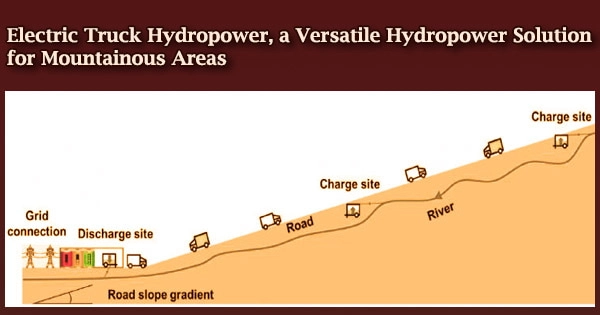Mountain locations contain a lot of hydropower potential that can’t be fully realized with current technologies. Julian Hunt of IIASA and an international team of academics created an innovative hydropower system based on electric trucks that could give a flexible and clean option for generating electricity in mountainous areas.
Hydropower will certainly become more important as a renewable energy source as we move toward a more sustainable future. Despite its potential, hydropower technology has been slow to develop during the previous century. The current methods rely on two connected reservoirs with differing water levels, where the water’s potential energy is transformed into power.
The potential for generating electricity from a tiny stream of water is significant in steep mountain regions; yet, these regions’ hydropower potential remains untapped since it requires storage reservoirs, which have environmental and socioeconomic consequences.
Electric Truck Hydropower is a novel technique created by IIASA researcher Julian Hunt and an international team of researchers that could become a vital way for electricity generation in steep hilly terrain. The study’s findings were published in the Energy Journal.
It is an interesting electricity generation alternative due to its high flexibility. For example, if a country is in an energy crisis, it can buy several electric trucks to generate hydropower. Once the crisis is over, the trucks can be used to transport cargo.
Julian Hunt
Electric Truck Hydropower would leverage existing road infrastructure to convey water in containers down the mountain, then use the electric truck’s regenerative braking to convert the water’s potential energy into electricity and charge the truck’s battery.
The generated energy may subsequently be sold to the grid or used to convey other commodities by the truck itself. Electric truck hydropower could potentially be used to create electricity in conjunction with solar and wind energy or to provide grid energy storage.
“The ideal system configuration is in mountainous regions with steep roads, where the same electric trucks can be used to generate hydroelectric power from different locations. This increases the chances that water will be available,” says Hunt.
The suggested technique is a cutting-edge, environmentally friendly source of energy that can compete with solar, wind, and traditional hydropower. Electric Truck Hydropower is estimated to have a levelized cost of $30-100 per MWh, which is significantly less than traditional hydropower, which costs $50-200 per MWh.
Electric Truck Hydropower has far fewer negative environmental consequences than conventional hydropower.
“This technology does not require dams, reservoirs, or tunnels, and it does not disrupt the natural flow of the river and fish passage. The system requires only roads, which already exist, charging and discharging stations similar to small car parks, a battery facility connected to the grid, and the trucks,” explains Hunt.
In terms of the technology’s worldwide reach, the research team calculated that Electric Truck Hydropower could create 1.2 PWh of electricity per year, or nearly 4% of global energy consumption in 2019.
The method could unlock previously untapped hydroelectric potential in steep mountain areas. The Himalayas and the Andes are the regions with the most potential.
“It is an interesting electricity generation alternative due to its high flexibility. For example, if a country is in an energy crisis, it can buy several electric trucks to generate hydropower. Once the crisis is over, the trucks can be used to transport cargo,” Hunt concludes.
















